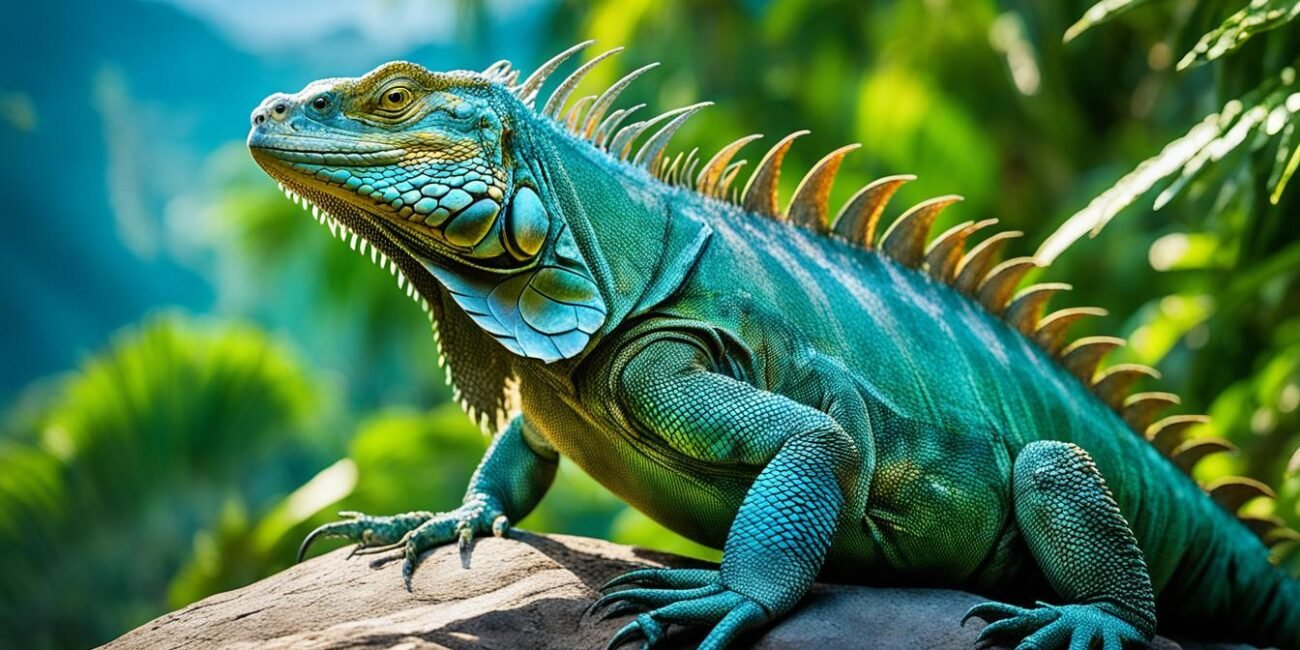I’ve always been drawn to giant iguanas because of their size and strength. These amazing creatures capture the heart of anyone who sees them. They live in the lush forests of the Americas and on the Galapagos Islands. The giant iguana world is truly a wonder to see.
Iguanas are fascinating to people all over the world. These big reptiles are herbivores and are known for their unique looks and actions. Their size varies a lot, depending on the species, gender, and where they live.
Key Takeaways
- Iguanas are large, herbivorous reptiles found throughout the Americas.
- The size of iguanas can vary greatly, with some species reaching lengths of over 6 feet.
- Environmental factors, such as diet and habitat, can significantly impact the growth and size of iguanas.
- Understanding the diversity and adaptability of iguanas is key to appreciating these remarkable creatures.
- Efforts to conserve and protect giant iguanas are crucial to ensuring their long-term survival.
The Colossal Lizards of the Bahamas
In the Bahamas, the giant iguanas of Allen Cay are a sight to behold. These endangered rock iguanas, known as the Allen Cays rock iguana (Cyclura cychlura inornata), have fascinated researchers and visitors for years. Their massive size and unique traits make them stand out.
Encountering Monstrous Iguanas on Allen Cay
Allen Cay, part of the Exuma chain, is home to a large number of these huge lizards. They can grow up to 1.5 m (4 ft 11 in) long, making them much bigger than iguanas on other islands. In just one generation, they doubled in size, a mystery that has intrigued scientists.
The Mystery of the Giant Iguanas
Allen Cay’s unique features help explain why its iguanas are so big. The island’s rough surface is perfect for the iguanas, and the seabirds there provide them with plenty of food. This rich diet has helped the iguanas grow to be the large creatures we see today.
Before the 1990s, these iguanas lived on only two islands, Leaf Cay and U Cay. But they have spread to nearby islands, including Allen Cay, where they have thrived. This move and the discovery of the giant iguanas have sparked interest among researchers and visitors, leading to a better understanding of these amazing reptiles.
| Statistic | Value |
|---|---|
| Total population of mature Allen Cays rock iguanas (Cyclura cychlura inornata) | at least 482 individuals as of 2018 |
| Maximum length of Allen Cays rock iguanas | close to 1.5 m (4 ft 11 in) |
| Increase in size of Allen Cays rock iguanas within one generation on Allen’s Cay | Twice as large |
| IUCN conservation status of Allen Cays rock iguana | Critically Endangered |
Unraveling the Enigma through Science
Researchers looked into the mystery of the huge iguanas on Allen Cay. They thought these giant lizards might eat seabirds and their droppings, not just plants. They used stable isotope analysis to find out.
The study showed that the iguanas on Allen Cay were actually vegetarians. They ate only the plants on their island. This was a big surprise.
The iguanas got big because of the nitrogen-15 in the plants they ate. This nutrient came from a nearby seabird colony. These birds made the plants rich in nutrients, helping the iguanas grow bigger than others.
“The seabird colony on Allen Cay was the source of this nutrient-rich fertilizer, which enabled the iguanas to ingest far more nutrients and grow much larger than their counterparts on the surrounding islands.”
This discovery was made with stable isotope analysis and studying seabird droppings. It solved the mystery of the Allen Cay iguanas. Now, we know how these amazing creatures got so big.
Giant Iguanas: Victims of Their Own Success
The giant iguanas of Allen Cay in the Bahamas were living their best lives. They thrived in a rich environment. But, their success led to their downfall. Two nonprofits tried to remove invasive mice, putting the iguanas in danger.
A team moved the iguanas to another island to protect them. But, 16 out of 18 iguanas starved because the new place didn’t have enough food. They missed the food they had on Allen Cay.
Now, Allen Cay has fewer than 10 giant iguanas left. Researchers are working hard to help them. The Bahamas National Trust and Island Conservation are leading the effort. They aim to fix the damage from introduced predators and habitat loss that threaten the iguanas.
The situation of the Allen Cay iguanas is a wake-up call. The work of these organizations is key to saving these amazing animals. We all need to support them for a better future.
“The giant iguanas of Allen Cay are a true marvel of nature, and we must do everything in our power to protect them. Their story is a testament to the importance of careful, well-planned conservation strategies.”
The future of the giant iguanas depends on us. With the help of groups like the Bahamas National Trust and Island Conservation, they might still inspire us for years to come.
The Astonishing Size of Giant Iguanas
Iguanas are known for their big size, from over a foot to almost seven feet long. The Green Iguana can grow up to 6.6 feet long and weigh up to 20 pounds. The Rhinoceros Iguana can be as long as 4.5 feet and weigh 10-20 pounds. The Galapagos Land Iguana can even be over 5 feet long.
Factors Influencing Iguana Growth
Many things affect how big an iguana can get. These include genetics, what they eat, and their environment. For example, blue iguanas can be up to 5 feet long and weigh over 30 pounds. Female iguanas usually get about 3 feet long and are over 10 pounds.
It takes about 4 years for iguanas to fully grow. But, some may keep growing for another 3 to 4 years. Some can be as long as 5 to 7 feet and weigh 13.2 to 17.6 pounds.
The common green iguana can be 5-7 feet long and weigh 10-20 pounds. Males can sometimes be over 7 feet long, while females are about 5 feet. Desert iguanas are much smaller, only about 16 inches long. Spiny-tailed iguanas grow to 10-18 inches.
“Iguanas, particularly green iguanas, have become an invasive species in various regions, notably in South Florida.”
The reasons behind the giant size of iguanas show how diverse and adaptable these lizards are. They are fascinating to researchers and nature lovers.
Challenges and Conservation Efforts
The giant iguanas of the Bahamas and Galapagos Islands face big challenges. These unique reptiles are threatened by predators and losing their homes. But, conservationists are working hard to save these huge lizards and their homes.
Introduced Predators and Habitat Loss
Introduced predators like rats, mice, and cats are a big threat to giant iguanas. These invaders eat the iguanas’ eggs and young. Also, invasive plants like goats are harming their homes.
To fight these threats, the Galapagos National Park and partners are working hard. They remove predators and fix the iguanas’ homes. This needs special care and knowing what the iguanas need to live well.
| Conservation Effort | Outcome |
|---|---|
| 15 conservation enthusiasts participated in an expedition to Wolf Volcano | Discovered 3 pink iguanas between 2-5 years old, a significant finding for the critically endangered species |
| Over 1500 hours of collective work by the expedition team | Contributed to the long-term conservation of the pink iguana and other species on Wolf Volcano |
| Chemical control applied to 140+ guava plants on the west flank of Wolf Volcano | Helped eliminate invasive plant species and restore the native habitat |
Conservation Efforts for giant iguanas show how much researchers, park rangers, and groups care. They tackle the problems of predators and habitat loss. This helps ensure these amazing creatures can live on, which is key to their island homes.
giant iguana
The giant iguana is a remarkable reptile that captures the hearts of nature lovers. These lizards can grow up to several feet long and weigh over 20 pounds. They are truly awe-inspiring. Their unique look, plant-based diet, and behaviors make them fascinating.
Thinking about getting a giant iguana as a pet is tempting. But, it’s important to know the big commitment they need. These reptiles need a special home, a certain diet, and a deep understanding of their needs. Owners must be ready to spend time, money, and show love for their iguana.
Exploring the world of giant iguanas is an exciting journey. It’s filled with challenges and great rewards. Learning about their biology and giving them the best life is rewarding. By diving into the amazing world of giant iguanas, we learn more about these reptiles and their role in nature.
| Giant Iguana Statistics | Value |
|---|---|
| Maximum Length | 6 feet (1.8 meters) |
| Maximum Weight | 20 pounds (9 kg) |
| Lifespan | 15-20 years |
| Diet | Herbivorous, mainly eats leaves, flowers, and fruits |
| Habitat | Tropical and subtropical areas, often by coasts and small islands |
Deciding to have a giant iguana as a pet is a big step. They need special care, a good home, and understanding of their needs. By thinking carefully about the responsibilities, owners can make sure their iguana is happy and loved.
“The giant iguana is a true marvel of nature, a living testament to the incredible diversity of life on our planet. To care for one is to embark on a journey of discovery, unlocking the secrets of these remarkable creatures and forging a deep bond with a truly unique companion.”
If you’re drawn to the giant iguana’s size, diet, or look, there’s much to learn and appreciate. By getting a giant iguana with care and responsibility, you can help these amazing creatures thrive. You’ll also contribute to their protection.
Conclusion
Giant iguanas have always fascinated people who love nature. They range from the huge ones in the Bahamas to the endangered ones in the Galapagos. These massive lizards amaze and intrigue us all.
But, they face big challenges like predators and losing their homes. We need to keep working to save these special animals. Looking at successes like saving Jamaican Rock Iguanas shows us why we must protect their homes.
If you think about getting a giant iguana as a pet, know it’s a big responsibility. They need special care and a lot of time. By caring for these iguanas, we help keep their world safe for the future. This way, we can all enjoy these amazing creatures for years to come.
FAQ
What is the average size range for iguanas?
Iguanas can grow from over a foot to almost seven feet long. The biggest ones include the Green Iguana, which can be up to 6.6 feet long and weigh 20 pounds. The Rhinoceros Iguana can reach up to 4.5 feet and weigh 10-20 pounds. The Galapagos Land Iguana can also be over 5 feet long.
What factors can affect the maximum size an iguana can reach?
Several things can affect how big an iguana can get. These include their genes, what they eat, and their living conditions. Things like temperature and humidity matter too.
What is unique about the giant iguanas found on Allen Cay in the Bahamas?
The iguanas on Allen Cay were really big, twice as long and six times heavier than others. They lived in a place full of nutrients from seabirds. This helped them grow much bigger than iguanas on other islands.
What challenges do iguanas face, and what are the conservation efforts to protect them?
Iguanas face big challenges like predators like rats, mice, and cats. They also lose their homes to invasive species. The Galapagos National Park and others are working to save them. This includes the pink iguana, which is in danger.
What should be considered when owning a giant iguana as a pet?
Having a giant iguana as a pet is a big responsibility. It means you need to know a lot about their care. They need special food, lighting, and the right humidity and temperature. Making sure they are healthy is key before getting one as a pet.
Source Links
- https://vocal.media/petlife/discover-the-astonishing-size-of-iguanas-how-large-can-these-reptiles-really-grow – Discover the Astonishing Size of Iguanas: How Large Can These Reptiles Really Grow?
- https://www.atlasobscura.com/articles/giant-bahamian-iguanas – Solved: How the ‘Monstrous’ Iguanas of the Bahamas Got So Darn Big
- https://www.metropolitan-touring.com/blog/nature/the-only-marine-iguanas-in-the-world/ – Getting to Know the Only Marine Iguanas in the World
- https://en.wikipedia.org/wiki/Cyclura_cychlura_inornata – Cyclura cychlura inornata
- https://www.iucn-isg.org/latest-news/allen-cays-iguana-research-update-2015/ – Allen Cays Iguana Research Update 2015
- https://en.wikipedia.org/wiki/List_of_largest_extant_lizards – List of largest extant lizards
- https://thedinosaurs.org/dinosaurs/iguanodon – Iguanodon | Life and Legacy of an Early Cretaceous Marvel
- https://www.galapagos.org/site-map/ – Site Map | Galápagos Conservancy
- https://www.science.gov/topicpages/i/iguanas conolophus pallidus – iguanas conolophus pallidus: Topics by Science.gov
- https://en.wikipedia.org/wiki/Cyclura_nubila – Cyclura nubila
- https://people.com/pets/florida-man-finds-iguana-in-bathroom-toilet/ – Florida Man Goes to Brush Teeth — And Finds Iguana in His Bathroom Toilet: ‘Total Chaos’
- https://www.heraldtribune.com/story/news/2004/08/30/iguanas-propagate-pester-in-south-florida/28821955007/ – Iguanas propagate, pester in South Florida
- https://iguanacontrol.com/how-big-can-iguanas-get/ – How Big Can Iguanas Get: Understanding Iguana Control’s Expertise and Solutions
- https://galapagosconservation.org.uk/species/galapagos-land-iguana/ – Galapagos land iguana – Galapagos Conservation Trust
- https://www.galapagos.org/about_galapagos/biodiversity/ – Biodiversity | Galápagos Conservancy
- https://www.galapagos.org/newsroom/successful-expedition-2023-on-wolf-volcano/ – Successful Monitoring of Pink and Yellow Iguanas, Giant Tortoises at Wolf Volcano | Galápagos Conservancy
- https://pasifika.news/2024/05/preserving-fijis-iguana-heritage-a-conservation-effort/ – Preserving Fiji’s Iguana heritage: A conservation effort
- https://galapagosconservation.org.uk/our-work/projects/iguanas-from-above/ – Iguanas from Above – Galapagos Conservation Trust
- https://www.ebay.com/itm/126065234028 – Vintage 90s Giant Iguana Mountain bike 27” frame | eBay
- https://www.iguanafoundation.org/2023/12/15/jamaican-iguana-conservation-success/ – Jamaican Iguana Conservation Success – International Iguana Foundation
- https://www.whiteclouds.com/blog/giant-iguana-prop/ – Giant Iguana Prop – WhiteClouds
- https://en.wikipedia.org/wiki/Green_iguana – Green iguana











No Comment! Be the first one.